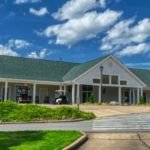Hot Springs Village Board of Directors met for the first public meeting on Wednesday, January 15, 2020. The Directors in attendance were Chairperson, Cindi Erickson; Vice-chair, Tormey Campagna; Director Diana Podawiltz, Director Mike Medica and Director Buddy Dixon.
Also present were CEO and Corporate Secretary, Lesley Nalley; and CFO and Corporate Treasurer, Liz Mathis.
Parliamentarian and Director Nancy Luehring had an excused absence to attend a medical appointment with her husband.
Below please find the Corporate Secretary/CEO presentation from the January 15, 2020 Board Meeting.
CFO is reporting sooner
Nalley: The CFO and her team put in long, hard hours and CEO Nalley was appreciative of this. “January 1st fell on the first Wednesday of the month, which completely squeezed our year-in-close schedule, so that is one of the reasons why in her report you will see a simplified report.” The CFO is preparing a more detailed report.
Nalley: In the past year end results were not reported before February. In the last three years they have tried to report as quickly as possible, “at least the high-level look at our financials.”
Achievements/misses related to the Enterprise Goals
Nalley: “For those Board Members who were on the Board last October, 17, 2018, you will remember that the 2019 Enterprise Goals that were set at that time. So the achievements that I am talking about or the misses that I am talking about relate to the charge that was given us when that budget was first set.”
Nalley: “I am very proud of the fact that we did not decapitalize our assets. Capital spending outpaced depreciation. Our owners’ equity grew by $265,000 and as you all recall, one of the enterprise goals was that it at least meet or exceed current equity. That’s important because that is the balancing of how we are spending our cash on what.”
Nalley: “We did miss the bottom line operating budget by $259,000 or .7 % of our net revenue and I think we know the reasons for that. Liz will go into several of those and I will mention some here.”
Nalley: “However, even though we missed the bottom line operating budget, through our capital spending controls, we will remain able to fund reserves. We did sell 30 POA lots and our number of improved properties grew by 60.”
Nalley: “Now not on the list of Enterprise Goals, but certainly achievements that we’re proud of:
- Workers’ Compensation expense has decreased by 3.4 % over 2018.
- The Administration Division posted a $419,000 reduction from 2018 and was $266,000 under budget.
- Likewise, the Community Development and Marketing Division posted a $246,000 reduction over 2018 and was $338,000 under budget.”
Nalley: “So with that, I also noted in here some of the reasons why we continue talking about new home construction and repairing our broken community funding model through alternative revenue streams.”
Nalley: “We’ve talked a lot about our challenges with regard to assessment revenue and some of the reasons why the Comprehensive Master Plan was originally discussed and lastly brought forward.”
Nalley: “If you notice in the financials, there was a 2% decrease in net assessment revenue over 2018. When you consider the fact that the 2019 Southern CPI factor was 2.7% and 2020’s was 1.1%, you see that we are going backward. There is a whole page discussion of that in the Comprehensive Master Plan. It is one of the reasons why that 5% number was initially brought up. So we haven’t solved that issue that our current incremental, smaller incremental growth assessment revenues are actually taking us backward in terms of the bad debt.”
Nalley: “Before the year-end write-offs and in Liz’s report, she notes that they wrote up $4.9 million of previously accrued bad debt at the end of 2019.”
Nalley: “But before those write-offs, there were nearly seven thousand unimproved properties with assessment balances greater than $1,000. This represented $3.3 million per year in loss of assessment revenue.”
Nalley: “And then finally, the 2019 provision for bad debt ended at $3.9 million. That exceeds the $2.3 to $3.0 million annual lift that was expected from the two-tier assessment. So in other words, we haven’t corrected the assessment funding imbalance. Any questions on that page before I move on?”
[Medica asks a question but it was very low and I didn’t catch it.]
Nalley: “It is quite a large gap.”
Reserve funding
Medica: “Do you know what that equates to as far as funding for our reserves?”
Nalley: “Well, we are still able to meet our target for reserves, but we could have certainly done more. We could have certainly also handled more deferred maintenance. But the point there is that there a gap between the bad debt and the new assessments.”
Podawiltz: “I have a question. Actually I have several questions. You made a statement that through capital spending controls, we remain able to fund reserves. Would you expand upon that? What kind of controls are you talking about?”
Nalley: “Yes, and this is one of the things that when Liz does her final report to you all for the year, each year she identifies the things here that we weren’t able to take care of. They were budgeted, but we weren’t able to take care of. Sometimes that is just for timing and sometimes that is because of our operational results were off. So what we do, throughout the year, and you all will remember that we discussed this throughout the year in our Board meetings. Throughout the year we began to reprioritize those budget items and hold the items, whether it’s a vehicle purchase, whatever the item is, that kind of drops to the bottom.”
Podawiltz: “So basically what you are saying is that we held these items. Equate it to a household. I was going to put new carpeting in my house this year, but funds weren’t really there for it. Wasn’t comfortable spending so I’ll do it next year. Kick the can down the road.”
Nalley: “That’s right.”
Podawiltz: “So that’s the control factor there. Okay.”
Erickson: “Is it not also true though that other things could cause us, like if we had chosen to spend a million dollars on a capital purchase, but through good negotiations we only spent $900,000 on that purchase – the savings that indicate that capital didn’t get spent. I mean there’s lots of ways, right? – where that capital budget maybe didn’t get fully consumed. One of which is because we didn’t have the resources to do it. Is that true or not?”
Nalley: “That’s true. You will recall every year we talked about some type of emergency or a surprise, whether it…One year we had a major culvert go out. So, as things come up throughout the year, whether it is that we got a better deal than we thought or whether it was something came up that was a higher priority than something else listed. We deploy those anyway throughout the year.”
Podawiltz: “Okay, but basically what we are saying here is that the reserve number is already identified for specific use.”
Nalley: “No, that is something that you all talk about when we do the…”
Podawiltz: “Okay, that is fair enough.”
Nalley: “No, let me finish, if you don’t mind, Diana.”
Podawiltz: “No that is fine. You answered the question. It doesn’t really apply to that. There are other issues to be involved by the Board.”
Nalley: “I do want to tell the rest of the Board when you will hear about that. You will have a, make a decision on what to roll over and what not to roll over. So be very, very clear what didn’t occur.”
Owners’ equity
Podawiltz: “Okay, so going to accounting venacular and I’ve stated this many, many times in the past that basically owners equity is an accounting equation. I mean it is just assets minus liabilities equals owners equity. And I’d like to point out that one of the increases we have in assets, assets did increase and one of the increases came from the fact that our amount of land held for resale increased and that liabilities went down because we paid off about $500,000 of debt and that too lent itself to the increase of owners equity. Thank you.”
Nalley: “You are exactly right. Which is what you want to see. You want to see that debt going down. You’re able to …”
Podawiltz: “But ideally, I’d like to see my owner’s equity increasing because of operating results, which we can talk about that when Liz gives her report.”
Podawiltz: “You wanted questions from the whole group here, so I have some more.”
Podawiltz: “How much of the $266,000 that we were under budget in the Administration Division, can be attributed to the fact that the CMEO position was not filled until mid-year but yet it was budgeted for the entire year?”
Nalley: “A small percentage of that. But also what happened, if you will recall, we shifted and restructured and moved some of what we originally were going to spend in administration and did things in other departments, like our Safety Department, like our Public Works Department. So some of that was very intentional shifting as we restructured positions.”
Podawiltz: “Okay, so as presented, it really wasn’t across the Board enterprise $266,000 under budget. Some of this went to other divisions. And I suppose the same thing could be said then about the community development in marketing. There was some shift there?”
Campagna: “Diana, I don’t think that is what she said. She said she moved work. She didn’t say she added people in other areas to do the work.”
Podawiltz: “No, but she says that she is $266,000 under budget, but that isn’t under budget across the entire enterprise.”
Nalley: “Obviously that is correct because as I say in my first statement, ‘we missed the bottom-line budget.’ Right, so your statement is correct.”
Podawiltz: “Okay.”
Nalley: “What I am pointing out is that in the two divisions that people most had concerns about, we deployed expense control measures and we altered the structure so that those two divisions did not take the same resources that they previously had. That was a very intentional shift to our other operations.”
Podawiltz: “But other divisions did pick up some of the resources that they did use. Thank you.”
Nalley: “As they needed to; as we discussed.”
New rooftops
Campagna: “I have a comment regarding the 60 new rooftops. And I am glad we made our goal. So, don’t get me wrong here. I believe that’s about a 5.6 percent increase from last year in rooftops. In the U.S. in 2019, new home starts went up by 13.6 percent. So we are lagging there. Now if we had compounded growth at 13.6 percent, we’d get to a lot of rooftops pretty quick. And the fact that we’ve got, I think 75, in the goal for 2020 means that would be, roughly, 25 percent growth. Or be exactly 25 percent growth. This would be good news if we make that goal. But we need to clearly understand the lack of growing at the annual U.S. rate is detrimental because in reality in business, if you’re not moving forward, you are standing still or you’re going backward.”
Nalley: “Yeah, I would completely agree with that, with this one caveat. Arkansas has never felt the hit like the rest of the nation and it’s never felt the growth like the rest of the nation. So to some degree, we have to acknowledge the fact that our results won’t track exactly.”
Nalley: “However, with the Comprehensive Master Plan, we said we need to get to 125, so 75 is even off of where we feel like we need to be for our community.”
Campagna: “I wouldn’t disagree and I think that everything that you said is accurate, but with more and more baby boomers retiring every day, that opportunity for us to get a bigger share should be there. And I am confident, or I’m being hopeful, let’s put it that way, that with the relationship that’s being proposed with Sells, that that’s going to drive us to a heck of a lot more rooftops than 60 or 75 in short order.”
Nalley: “Yeah.”
Comparing HSV with other communities
Podawiltz: “How does our growth percentage compare to our local region – to Hot Springs, Little Rock, Conway, those areas?”
Nalley: “So really what should have happened about 2014, in the Village, is that we should have been tracking alongside what was going on in Benton and Bryant. They were growing way ahead of us and that’s one of the things that I mean, well a lot of people were still talking about there was a decline around the rest of the nation. In Arkansas, beginning in 2014, you were seeing a residential development boom then. Now obviously it is going to happen closer to the city centers, Right? Closer to the jobs. Those types of things. And we did not have a program at that time. Our program kicked off in 2017. So we lost about three years there.”
Podawiltz: “Okay, but our program kicked off in 2017. So instead of talking about five years ago, how did we reflect last year against the regional areas?”
Nalley: “I would say that we were somewhat lower, but not materially lower. We were actually higher than some of the areas.”
Podawiltz: “Could you bring that to us next month?”
Nalley: “Sure if that is something that the Board would like, I’ll be happy to bring that information to you. You all can let me know.”
Medica: “Well, okay but you know we are talking about something here that’s, let’s take Conway. They bring in business. They’re bringing in people who are going to buy homes. So I am not sure that…I guess I am not sure what you’re going to compare against. Cities are somewhat different than [indecipherable] communities. We’re looking at a certain group. Where cities are, they are going to sell whatever they can as quickly as possible.”
Campagna: “I think a reasonable comparison, and you’re highlighting on it, is to other communities of similar nature. And I realize there aren’t necessarily any directly the same. But if someone comes into your town to build a big manufacturing plant, you’re going to get more growth. Unfortunately, I guess I call it ‘fortunately’, nobody is planning to build manufacturing plants inside the Village.”
Nalley: “And I think the other thing to keep in mind is that there were several new, similar communities like ours, much smaller scale. So to some degree the demand, the supply, I’m sorry, of this type of community grew exponentially in the last few years with a much newer product, a much different product in some cases. If you compare us to Bella Vista, Bella Vista grew. Now Bella Vista’s growth tracked along the same line as their commercial growth and their industry growth. So its…I think the bottom line is, we’d like to grow more and that’s what we need to do.”
Medica: “Yesterday I happened to be watching TV, which I don’t do a whole lot of. But there was a, one of the channels had a real estate person on there who was very excited about the next few years. His take was, what he was saying was young people were buying homes at a much faster capacity. Which means maybe they are moving out of their parent’s home or whatever. I don’t know. But the job market obviously is very good. So the real estate industry is doing fairly well and has a bright future in the fact that, I learned this morning, we only have 140 some homes for sale in the Village. And that is a very low percentage. Very low. So, we need new homes and that’s why I have a bright outlook for what Renaissance is doing. We need those as fast as we can get them.”
Golf/Food & Beverage disappointing results
Nalley: “Okay. Alright, so moving on to golf. You see my highlights there, of both Golf and Food and Beverage. Posted both disappointing results and some glimmers of bright spots throughout. And so, particularly in golf, I want to point out that DeSoto, Coronado and Isabella exceeded 2018 revenue. So despite the big downturn, there is something to be learned there about those and as we dig in, we will learn more about that.”
Nalley: “Obviously we’ve talked about the number of rounds and playable days, member rounds, you know the difference between, ‘are you playing 18 holes or 9 holes,’ all of those things that went into not only the weather but just our player mix.”
Both Golf/Food & Beverage bright spots
Nalley: “The bright spot there – golf package plays – so this is visitors. Visitor golf was up $95,000 over 2018. So we are seeing traction there with visitors. And we continue to evaluate that supply and demand of those eight courses and we know that it’s been challenging as we’ve closed courses. It’s challenging for our team. It’s challenging for our vendors who have restaurants at those courses.”
Rediscover Hot Springs Village initiative
So one of the things that we are doing to combat that is a “Rediscover Hot Springs Village” initiative in 2020 and what that initiative is, is taking a look at all of the, there are about 1,500 homes that are on golf courses and lakes. Excuse me, 1,500 unimproved lots that are on golf courses and lakes and our thought in 2020 is a very heavy marketing focus on getting golfers to build on the golf course – people to support those, if you will. You will see a lot of our marketing – a very heavy golfing focus and specific to those 1,500 unbuilt lots.”
Campagna: “Question. Of the 1,500, how many of those lots are in our 3,800 inventory?”
Nalley: “Very few. Most of them are not. I think we have 11,000 for sure that we have identified. I am looking over at Renee [Haugen, Director of Real Estate Acquisitions] that are current people, other people own them. We will be sending a letter to them that basically says, ‘Please come rediscover Hot Springs Village and by the way, if you begin building a house in 2020, we’re going to refund your Discovery fee. You will see that launched. That’s just a little tidbit there, but that’s what we’re working on right now. So very few.”
Nalley: “Renee, any idea how many we own?”
Haugen: “We own about 57.”
Nalley: “57.” So obviously we will be, you will be marketing those as well.”
Podawiltz: “Can I get just a little clarification? When you say ‘On’ – when you say ‘On a golf course’ – ‘On a lake’ …so they are touching that lake.”
Nalley: “That’s right. That’s right. So 1,500 unimproved lots that are touching, that somewhat tells you why we have a capacity issue on our golf courses.”
Podawiltz: “Because the 1,500, these are primarily on golf course?”
Nalley: “Those are all on golf courses. Yeah, that is right.”
Podawiltz: “I thought you said that we had 1,500 on golf courses and lakes.”
Nalley: “I’m sorry. ‘Renee, do you remember the split between golf courses and lakes? The lakes is a smaller number.’ Lakes have been pretty well built out and I don’t remember the exact split.’”
Haugen: “About 200.”
Nalley: “About 200, Renee is saying of the 1,500. So, yeah and some of that though, some of that is people bought next to their home, so they bought the land next… Right. So they’re not going to be, you know, so those…they did that intentionally.”
More on missing the Food & Beverage budget
Nalley: “So Food and Beverage, obviously we missed the budget. We missed it by $342,000. We were actually behind 2018 by $74,000. However, Magellan, Balboa Club, Ponce Center Bars and Granada Grill, all increased their revenues. So they were pushing hard. Magellan, Balboa and Granada all posted reduced subsidies, so we are proud of them for that. As I mentioned the weather and the course closures, no doubt impacted that. However, one of the midyear restructures that we did, related to Food and Beverage and we began to see at that time some progress and traction improving our Cost of Goods Sold and our Cost of Labor. And the team enjoyed a busy holiday season. So some bright spots [indecipherable] there.”
Nalley: “Village Homes and Land…”
Podawiltz: “Can I go back to Food and Beverage for just a second? Liz addresses this in her report, too. I don’t know if I should save it for her report or ask it now. We always are referring all the time to the fact that we didn’t take over operations of DeSoto until April 1 of 2018. So for comparative purposes, it’s rather difficult. I don’t know how much work it would be for, to pull out our April through December 2019 results so that we could compare – just see that – a one-time shot at that. I mean that issue is going to go away as soon as we hit April of this year.”
Nalley: “That time frame?”
Podawiltz: “That time frame.”
Nalley: “And all of these types of discussions, as Liz brings forward the other pieces of information, as the Board decides on these pieces of information, we’re happy to include any of that. So you all just let us know what pieces are most important to you.”
Food & Beverage labor costs & reports
Campagna: “Comment on that. Labor costs. If I am not mistaken, at many of these POA-owned facilities, we’re still paying the wait staff minimum wage.”
Nalley: “That’s correct.”
Campagna: “Heres the…”
Nalley: “Beginning in 2020 it begins to shift. Right? We didn’t increase them to the new, right? But yes, we are not paying them $2.00 an hour is your point.”
Campagna: “And my point is, that is the reason why our labor costs are high. But on the other hand, the course to that point, because the volume is not enough to where those individuals could earn the tips that would get them even to the minimum wage, in many cases – let alone make reasonable income. Now that in turn, is not going to get fixed until we all start eating at our own restaurants more and tipping like crazy so that we can get out of the $8.75 wage or whatever.”
Nalley: “Yeah, that’s, I mean that has always been a point, a decision point we’ve looked at every year. We’ve had, you know, restaurants since the beginning of time here and we have all the data. I told you before we were subsidizing a half a million dollars a year on average when we had two main restaurants. Part of that was, you know, just an intent to subsidize. But the other part was, we’re going to have to pay them minimum wage, one way or another, whether it is through tips or through us. So, we hope that this year, by not increasing it to the new minimum wage, that we have not created any gaps. But we will evaluate that every pay period.”
Podawiltz: “So, let me understand this. So we are responsible as an enterprise to make sure that our employees are at least earning the minimum wage.”
Nalley: “Yeah.”
Podawiltz: “So they report their tips and if that doesn’t and we know their hours, and if the two of those together would not equate to what they would have been paid at the minimum wage, then we must make up that gap every pay period.”
Nalley: “That’s correct.”
Podawiltz: “People have got to tip more.” (laughter)
Podawiltz: “But back to my question, should I raise that question before the Board? Is anyone else interested in seeing a one-time shot at what DeSoto club did April through December of 2019 so that we could have that comparison to April to December of 2018, just from a knowledge basis?”
Medica: “Not really.” (laughter)
Medica: “I hate to say it. Food is very difficult. In fact, I have a father-in-law that told me the worst thing the government ever did was have waitstaff report tips. That really killed a lot of business.”
Campagna: “To your – the question you raised – I think it would be interesting, but I think I can personally get enough by looking at the nine months that we did operate DeSoto for 2018 or roughly nine months and comparing it to 2019 and probably develop a good enough understanding. Then at the end of the first quarter, the first three months, I could compare these three months to the three months of ’19 and if it was way up, I’d be excited. And if it was down, I’d say, “Geez, we haven’t done as good a job as we hoped.’ So it would be interesting to have it, but I can live without it.”
Nalley: “You can also get it – remember Liz does a quarterly report. So you can take the March, 2019 Quarterly Results. And you know what that number is and just pull that out.”
Nalley: “But what we’re going to do is you all are talking, Liz and I kind of talked about this offline, is we’re just going to kind of make notes of the things that come up. So hopefully we will have a list of questions that you asked here, that we can look at and decide which were most important to you all.”
Village Homes & Land 2019 profit of $584
Nalley: “Okay. Alright. Village Homes and Land – that operation is closed as of 12/31. I just noted here that that operation, posted a net profit for the year of $584. We almost panicked Cindi as she called and said, did you post half a million dollars profit. Because normally we don’t talk in such small numbers. And of course, what is that? That is not our marketing spend. We’ve spent that marketing money since the beginning of time. Village Homes and Land did not change that. Did not add to that or decrease it and so I didn’t take that into account – a separate marketing budget, but it did actually post a bottom-line net profit.”
Real estate partner program
Now we’ve already talked about the other Village real estate and how new home permits were ended ahead of the last seven years. Existing home sales are outpacing those years. We have a 24 percent decrease in the number of homes that are listed. But what I am most excited about and Tormey alluded to this, on January 6, we kicked off the Real Estate Partner Program. And seven brokers who represent roughly 90 realtors are in that program. Their pictures are there for you. For the first time in POA history, we’ve featured these agencies on our real estate page of our website. So when you see kind of a little snippet there, of that webpage, if you haven’t visited there, check that out. Basically you land on that page and you have an opportunity to click on any one of their logos and get directly to their websites. So that will drive direct leads and then all of the other leads that we receive from our marketing efforts, we internally worked out a system for those that attended our Kick-off. You saw we pulled [straws] for the order of lead distribution and how that order went. And so each of those firms will receive all of the leads throughout the year. They received their first leads from us the day after our Kick-off. And we have some more coming up as soon as the team gets back next week or week after next from the ideal-Living show. [Click here to see details of the ideal-Living show January 25-26.] And we have some more coming up as soon as the team gets back next week or week after next from the ideal-Living show.”
Discovery Packages
Nalley: “Congratulations to Kevin and Susan and his team. There were 81 Discovery Packages completed in 2019. That was more than double 2018’s partial year of 37. There were seven conversions in 2019 and six in 2018. I mentioned to you already the Rediscover Package and focused on the golf lots. We’re also going to heavily focus this year on our RV Packages. And definitely again, I want to say thank you to the Arkansas Department of Parks and Tourism for paying our booth rental fees over in ideal-Living or over in Chicago at the ideal-Living show where we will be in attendance along with Bella Vista, Fairfield Bay, Cherokee Village and one other that I didn’t put here, Holiday Island. We’ll be attending, all of us together. So that is exciting.”
Campagna: “Quick question.”
Nalley: “Yes.”
Campagna: “You may have answered this once before and I just can’t remember. If someone came down here on a Discovery Package and bought a listed house, by one of the realtors. Is that considered a conversion?”
Nalley: “Yes. If any homeownership, right? – built or purchased…”
Campagana: “Or a lot, if they bought a lot.”
Nalley: “Yeah.”
Podawiltz: “Are we considering in the, when we combine the conversions, I know of several occasions where people have bought a home, an existing home from a realtor and the realtor purchased the Discovery Package as a gift? You know, they always give you a gift when you buy. My realtors have always given me a gift. Maybe everybody else hasn’t gotten one.” [laughter]
Podawiltz: “I think that’s pretty much modus operandi for the realtors when you buy a home from them and some of the realtors have used the Discovery Package as that gift so that the purchaser could subsequently come to the Village, have a place to stay, either during the move process or doing some fix-up or that kind of thing.”
Nalley: “If you have an example…I don’t know the answer to that. But if you have a specific example. You have an example, Liz? You have an answer?”
Mathis: “I don’t have an example, but I do have an answer. We use the guest’s name that comes and visits and compare it the change in title of deeded ownership of a property. So that is where we are doing the comparison so it will capture any scenario like that and any scenario like what Tormey was asking. If deeded ownership of land changes and they visited on a Discovery Package, and we always have the guest’s names, because we [indecipherable], regardless of where the lead came in from.”
Podawiltz: “Can you tell me what month we started the Discovery Packages in 2018?”
Nalley: “April”
Podawiltz: “In April, so roughly…The reason I asked is because when I went back and looked at some older, I mean I see that we have 37 sold and 6 converted, so that was a 16 percent conversion rate at that time. And then we are at 81 and 7 converted, so we are at 9 percent. Granted it is not year total twelve months/twelve months comparison, but that is a decrease in conversion rate of 56 percent.”
Nalley: “Well, you have to remember that they don’t always buy in the same year that they went on a Discovery Package. So I can’t really say whether or not the conversion happened…I mean, I can go back and dig out that detail.”
Campagna: “There is also the law of small numbers.”
Nalley: “Yeah. The bigger the numbers…right…the more that percentage changes.” So, I think the important point…11 percent conversion is a nice rate. It is a nice rate. We’d love for it to be 100% or even higher, but we’re happy with that rate and hope to see it grow.”
Podawiltz: “Is there any followup done on the packages sold that are not converted with people that purchased them as to why they didn’t convert?”
Nalley: “Well, so each package has a tour by a realtor so any followup would happen by the realtor. Other than the survey that we do, as everyone takes those Discovery Package tours so we might glean some information from that, but really the realtor who’s been in contact with them is probably doing that followup more.”
Podawiltz: “Okay, so going forward in this program, is there some way…I’m not a marketing expert by any means, shape or form…But is there any way that we can get any better metrics on this as to how good the program actually works?”
Nalley: “Well one of the…you probably recall from seeing in the realtor partner program agreement that you all saw, there is a line in there that talks about metrics and tracking. Some of that is yet to be defined in terms of what…we don’t want to set up a situation where the realtors are having to report to the POA. Right? And so most of that information is going to be in their hands. But as a matter of group collaboration, we hope to build that information, so that we see those metrics and that tracking. What we will know for sure, what they’ve agreed to, is for us to identify the conversions. We also talk about each of them using some type of survey. But again, the POA should not be in a position to tell, to ask the realtors to report to them. We want to be very careful about that. We do want to share information. So to the extent that everyone is comfortable with, certain metrics, we’ll work on that.”
Coronado Center Area Deliberative Engagement
Nalley: “Okay, and then lastly, just very quickly, the Coronado Center Area Deliberative Engagement. If everyone takes a look at page 177 of the Comprehensive Master Plan and kind of dials back your memory to when the consultants were here giving presentations. They talked about different pockets where significant activity already occurs and Coronado Center was one of those areas to be looked at. How is it working well? How could it work better?”
Coronado Center Specific Interventions Pgs 176-178 from the CMP
Coronado-Center-pg-176-to-178Nalley: “Stephanie [Heffer, Director of Placemaking and Development] and Stacy [Hoover, Director of Recreation] have spent a tremendous amount of time, talking individually in group settings to all the various different stakeholders. I’ve listed that here. I guess the long and short of it is that conversations continue about Coronado Center and that area. Obviously, as you know, we don’t own the strip mall and we don’t own the churches and so we are not looking at coming in and imposing anything onto those landowners, but we are having conversations about how can we improve the area. I mentioned here, there are 200 homes in that area, so from a Property Owners’ Association purpose perspective, our purpose is to preserve the value of the real estate. I mean I am paraphrasing. So why are we interested in this area? There are several commercial businesses in that area. There are over 200 homes or around 200 homes in that area. So just making sure that it stays vital. That is the long and short of that conversation and we’ll continue to have those.”
And that concludes my report. I’ll take any other questions if you have them.” [No further questions were asked.]
CEO Report pdf
5CEO-ReportThank you for reading. In this transcription, I have attempted accuracy to the best of my ability. Please bookmark this page and check back often so you don’t miss any of the reports, articles, and videos. Thank you.
Click here to watch the CEO/Corporate Secretary give her report
Click here to join our Private Facebook Group
Transcribed by Cheryl Dowden, January 19, 2020












Kilroy
01/19/2020 — 5:09 pm
Thanks to Cheryl for her long hours of servitude to keep us engaged in the POA business. It is complicated. Nalley makes it like that. Always something crazy going on. Wish they could stick to keeping our infrastructure investment sound. It will bite us in the ass someday soon. We need a GM. Not a “ceo” wannabe.
Anonymous
01/19/2020 — 7:14 pm
Some day is now especially with a BOD who are “cooking” statistics. Met our goal of 60 rooftops???? 20 permits were “PULLED” late in the last month of the year, is that what you call Rooftops??? Not even started in 2019 but still counting towards your enterprise Goals?? The fact is those permits will not even be started in 2020 because of sleight of hand deals with the ACC. Fast acting management to avoid a 33% shortfall of goal.
Julie
01/20/2020 — 7:48 am
Only with the 1984 double speak of the “ceo” could a permit be called a rooftop….or an empty, barren lot a home, or a silly unreachable goal an “enterprise” goal, or a charade a “charrette”.
Insane.
Bob
01/20/2020 — 7:59 am
An alternative thought for the CEO groupies: There are two measurements. One being paid permits and one being new water hookups. As Cheryl likes to say go ask the POA for the records and report back to us, or at least those of you who are still members.
San Taylor
01/19/2020 — 7:45 pm
LN did a pretty good job of putting lipstick on a pig in interpreting her data for us. She does definitely need to be in politics.
Moe
01/19/2020 — 7:58 pm
FYI The Villages sold 2,429 new homes in 2019. We did 60, but not really.
They are the same size as we are in land area.
That’s 40 times more than we did.
How can this be?
Why the disparity?
And our goal is to try for 75??
Wow.
Gonna take some time.
Must be the missing town center.
Karen Daigle Lundberg
01/20/2020 — 7:21 am
Thank you, Cheryl, for your diligence in reporting. As always, you did a great job. I have a question. Was it just me, or did anyone else read a lot of double speak, or what people like to call “smoke and mirrors” in Lesley Nalley’s report? My first impression of what I just read was Lesley, in her normal spin on numbers and statistics, managed to slip in, without exactly stating it, that she met all of her Enterprise Goals, and would receive her bonus accordingly. Lesley Nalley has been a total failure as a “CEO” and even as a “GM,” if that was her title. She should not receive any bonus or bonuses based on fulfilling goals which she has clearly failed at every one of them! The second impression I got was that this “speech” of Lesley’s was so clearly rehearsed. I would love to know how many hours went into “coaching” her for this speech, because she certainly was struggling to report information she clearly did not understand. I assume that was the purpose of “kicking the can” down to Liz reporting the true numbers next month. They were NOT ready for this, and that was so clear reading this. Then we had Turncoat Tormey ever so gently reminding her of things, which I read as getting her back on track or reminding her of something that they had rehearsed. The whole report was nothing more than a rehearsal of a theatrical performance to “fool the Villagers.” It really is insulting that they believe the Villagers are such fools and are so ignorant. Insulting!! Lastly, a standing ovation to our ONE AND ONLY Board member who looks out for our well-being, and that would be Diana Podawiltz. Many thanks to you, Diana, for being the lone ranger in holding their feet to the fire and making them answer the hard questions. We will fight, fight, fight to get you an LTD to come stand by your side for you all to do right by the Villagers.
Andy Kramek
01/20/2020 — 9:47 am
Wow! Talk about double-talk! Our “ceo” is clearly an expert – taking just one example:
“Nalley: “What I am pointing out is that in the two divisions that people most had concerns about, we deployed expense control measures and we altered the structure so that those two divisions did not take the same resources that they previously had. That was a very intentional shift to our other operations.””
Translation: People were concerned about the expense of running two divisions, so we just moved people out of them and reduced the cost of those two divisions. What I won’t mention is that costs elsewhere increased by the same amount
Notice that they didn’t actually save any costs, just re-distributed it! This whole report is full of this kind of BS. Thank heavens for Diana asking questions that forced at least partial admissions. This nonsense has to stop!!!
steve bylow
01/20/2020 — 5:22 pm
Thanks for the great article!!!
A a simple request to Board members:
If we are going to pay POA executives like they are working for a “corporation” then please hold them accountable like most “corporations”.
For example;
1. Ask critical questions like fellow Board Member Ms. Podawiltz. Yes it may “create tension” but that is what Board members are expected to do.
2. Understand that executives who take credit for reducing budgets of several departments by shifting costs to other departments or kicking the can down by delaying initiates are considered disingenuous – it’s an integrity thing.
3. Understand executives who don’t meet reasonable shareholder expectations should not receive an incentive, wage increase or contract extension. Blaming the weather, economy, or “disgruntled few” should not factor into the decision – they are red herrings.
Thanks